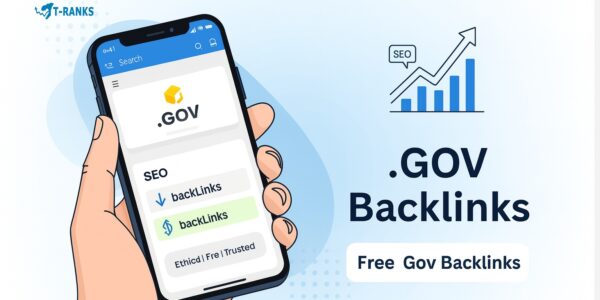.Gov backlinks are some of the most powerful links you can earn for SEO. They come from official government websites and carry high authority. These links boost your site’s credibility and search engine rankings. They also enhance trust signals—especially in competitive niches like health, finance, legal, and education..
But there’s a catch: many people try to get these links the wrong way. They buy cheap backlink packages, spam comment sections, or rely on outdated black-hat tactics. These strategies are risky, ineffective, and often lead to penalties from Google.
That’s why this guide focuses on safe, ethical, and completely free ways to earn real .gov backlinks in 2025. No tricks. No automation. Just proven methods that work—built on high-quality content, public-sector alignment, and manual outreach.
In this article, you’ll learn:
- What .gov backlinks are and why they matter
- The safest ways to get them for free
- 8 step-by-step strategies based on real examples
- What mistakes to avoid so you don’t harm your site
Let’s get started.
What Are .Gov Backlinks and Why Do They Matter for SEO?
.Gov backlinks are links from websites that use the .gov domain extension. These domains are reserved for government entities, which makes them highly trusted and authoritative in the eyes of search engines.
Because only official government organizations can register .gov domains, backlinks from these websites carry more weight than links from regular commercial sites. They are often seen as reliable sources of information, and earning a backlink from one signals to search engines that your content may also be trustworthy and useful.
These backlinks can come from different types of government departments, programs, or community portals. When earned naturally and ethically, they can contribute to better rankings and online visibility over time.
What Counts as a .Gov Backlink?
If you get a link from any government-run website that uses the .gov domain, it’s considered a .gov backlink.
These links may appear in various places, such as:
- Profile pages created during registration
- Public resource directories
- Event or grant listings
- Research documents
- Community service or outreach pages
For example:
Getting a link from any of the following websites is considered a .gov backlink:
- dmv.ny.gov – Department of Motor Vehicles
- sba.gov – Small Business Administration
- cdc.gov – Centers for Disease Control
- grants.gov – Government grant portal
- energy.gov – Department of Energy
- usa.gov – Central government services
These sites represent a wide range of government services. A backlink from them is a sign that your content may be useful, relevant, or informative to their visitors.
Why .Gov Backlinks Are So Valuable for SEO
1. They Have Very High Domain Authority
Government websites often receive backlinks from other respected and established sites. This results in very high authority scores, such as Domain Rating (DR) or Domain Authority (DA), depending on the SEO tool.
For example, dmv.ny.gov has a DR of 91, with more than 10,000 referring domains and over 450,000 backlinks in total.

This means a single backlink from such a site can pass strong SEO value to your website. It can help improve your site’s authority in the eyes of search engines, which may lead to higher rankings.
2. They Get a Lot of Organic Traffic
Most government websites rank for thousands of keywords and receive consistent traffic from search engines.
Dmv.ny.gov receives around 1.8 million organic visitors each month, with an estimated traffic value of over $1 million.
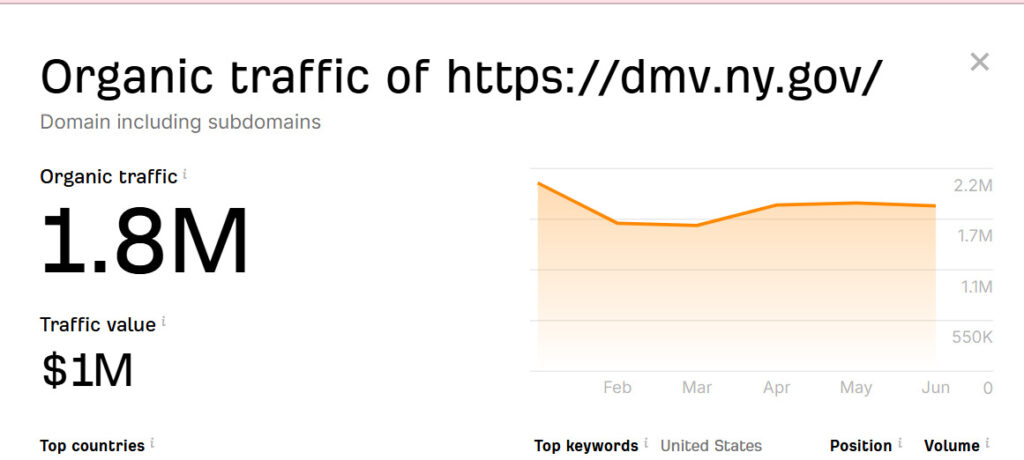
When your site gets a link from a popular government domain, Google is more likely to see your content as trusted. It may also get indexed faster or appear for related queries.
3. They Support Google’s E-E-A-T Criteria
Google evaluates content based on four main trust factors:
- Experience
- Expertise
- Authoritativeness
- Trustworthiness
Backlinks from .gov domains help support these factors. Search engines see them as a form of third-party validation, especially for topics that impact people’s lives—like healthcare, education, or finances.
If you work in a sensitive or regulated field, a .gov backlink can contribute to your site’s credibility.
4. They’re Rare and Can’t Be Faked
Only verified government departments or agencies can own a .gov domain. You can’t register one for personal or commercial use. This makes .gov backlinks difficult to get and hard to manipulate.
As a result, search engines tend to trust these links more than links from regular websites. You’ll need to earn them by offering helpful content or engaging with real government programs or portals.
5. They Stay Live for a Long Time
Government websites are stable and don’t change often. Once your backlink is published, it usually stays online for years.
This long-term stability means your SEO benefit doesn’t disappear quickly. It continues to support your authority over time.
6. They Usually Come from Relevant, Quality Pages
Most .gov backlinks are placed on pages that are designed to inform or assist the public.
You’ll often find them on:
- Resource pages
- Community service announcements
- Reports or research-based documents
- Public databases or directories
Because of this, the links are usually placed within contextually relevant content, which helps with both SEO and user trust.
Do . Gov Backlinks Improve E-E-A-T and Rankings?
Yes. .Gov backlinks can improve your search rankings and help support Google’s E-E-A-T signals — if they are earned naturally and placed on relevant pages.
Search engines trust .gov websites because they belong to official government organizations. A backlink from one of these sites shows that your content is reliable and worth referencing.
Google looks at four main qualities when judging content:
Experience, Expertise, Authoritativeness, and Trustworthiness (E-E-A-T).
If a government website links to your page, it helps signal that your content meets these standards.
Here’s how .gov backlinks support your SEO:
- They pass strong link equity because government sites have high authority.
- They boost topical relevance when the backlink comes from a page related to your niche.
- They send trust signals that help improve your site’s reputation in Google’s eyes.
These factors can improve your visibility in search results, especially in competitive industries like health, education, or finance.
But remember, .gov backlinks are not enough on their own.
They work best when you already have helpful content, a clean website structure, and good on-page SEO.
Think of them as a valuable signal that strengthens the rest of your SEO work.
Types of .Gov Backlinks by Government Leve
.Gov backlinks come from three main levels of government: federal, state, and local. Each type offers different levels of authority, accessibility, and SEO value. Understanding these categories helps you target the right sources based on your goals.
1. Federal .Gov Backlinks
Federal government sites are managed by national departments and agencies such as:
These domains have:
- Very high Domain Ratings (often DR 90+)
- Thousands of referring domains
- Strong trust signals in Google’s algorithm
How to earn federal backlinks:
- Contribute original research or public-use data
- Get cited in federal reports or whitepapers
- Partner on national education or public health projects
SEO impact:
- High authority
- Trusted by search engines
- Very difficult to obtain
2. State .Gov Backlinks
State-level sites are operated by individual U.S. states or regional governments. Examples include:
- illinois.gov – Illinois
- california.gov – California
- pa.gov – Pennsylvania
These sites may link to:
- Local business directories
- State-run educational or safety resources
- Public service portals
How to earn state backlinks:
- Submit resources to relevant departments
- Get listed in official state portals
- Collaborate on public awareness campaigns
SEO impact:
- Strong authority
- Easier to access than federal links
- Good for regional SEO strategies
3. Local .Gov Backlinks
Local government websites are run by cities, counties, or municipalities. Examples:
- nyc.gov – New York City
- lacounty.gov – Los Angeles County
- denvergov.org – Denver
These domains often have lower DR than federal or state sites, but they’re powerful for local search.
How to earn local backlinks:
- Get listed in event calendars or business directories
- Support local initiatives or government-led programs
- Contribute content or expertise to city resources
SEO impact:
- Great for local SEO
- Easier outreach opportunities
- High trust within local communities
Comparison Summary
| Government Level | Authority | Accessibility | Best For |
| Federal | Very High | Very Difficult | National citations and brand authority |
| State | High | Moderate | Regional SEO and government partnerships |
| Local | Medium | Easier | Local SEO and community engagement |
Ethical Ways to Earn Free .Gov Backlinks (8 Proven Strategies)
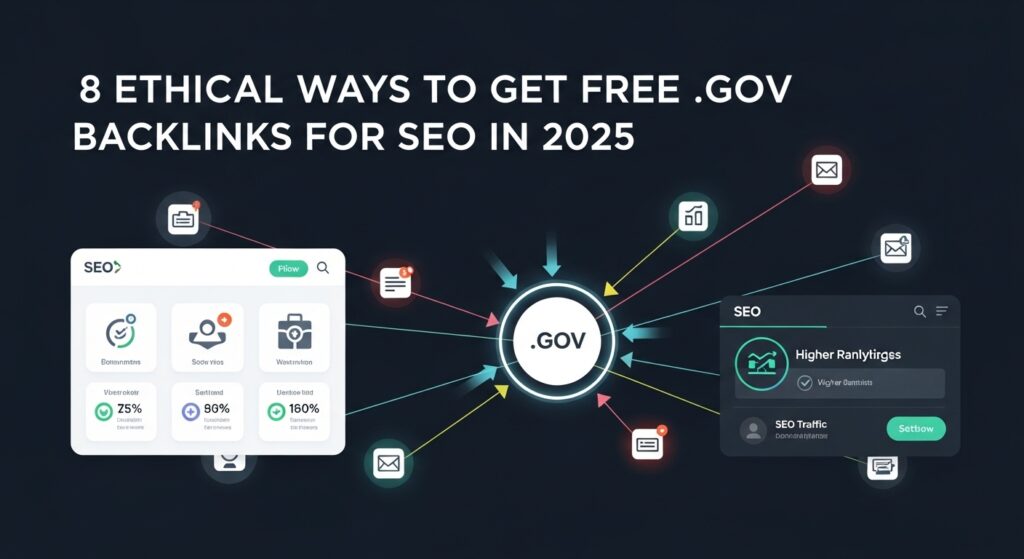
Getting a backlink from a government website can give your SEO a major boost. But to make it work—and avoid penalties—you need to earn these links in the right way.
.Gov sites are trusted and highly authoritative. Search engines see links from them as strong signals that your content is reliable and useful. However, you can’t buy or fake these links. They must be earned through ethical, white-hat methods.
In this section, you’ll learn eight real strategies to get free .gov backlinks:
- No spam
- No automated tools
- No shortcuts
Each method is based on offering genuine value—through useful content, outreach, or participation in public programs.
Let’s look at how you can build .gov backlinks the smart and safe way.
1. Get Listed on Government Resource Pages
Many government websites include pages that recommend tools, guides, and services to help the public. These are known as resource pages, and they often link to external websites that provide value.
If your site offers something helpful—like a free template, guide, or calculator—you can ask to be included. This is one of the easiest ways to get a high-quality .gov backlink without breaking any rules.
To qualify for these listings:
- Your content must be useful and easy to understand
- It should be relevant to the agency’s goals or audience
- It must look professional and avoid anything that feels like advertising
Example:
The Small Business Administration (sba.gov) shares resources to support small businesses. If your website has helpful tools (like business plan templates or funding checklists), you may be eligible for a link.
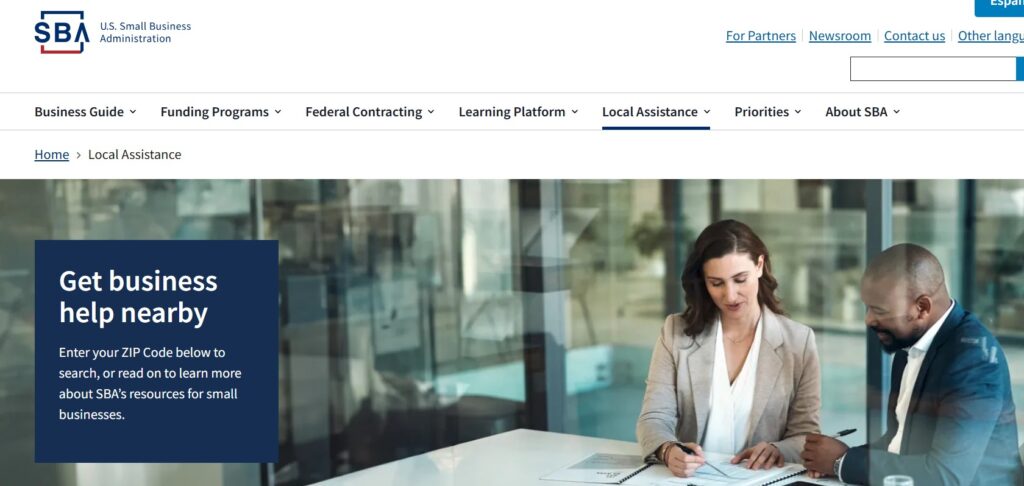

How to Find These Pages:
Use Google to search for pages like this:
site:.gov intitle:resources “small business”
site:.gov inurl:links “education”
site:.gov “recommended tools”
Look for pages that already include external links and are updated regularly.
How to Reach Out:
- Write a short, polite email
- Explain how your content helps their audience
- Include a direct link to your resource
- Offer to update it if needed to meet their guidelines
Tip: If you find a broken link on their page, you can suggest your content as a replacement. This often improves your chances.
Why This Works:
- These are trusted, permanent pages—not user-generated spam
- The backlinks are usually dofollow and contextually placed
- They pass authority and can improve rankings long-term
2. Contribute to Public Sector Blogs or Case Studies
Some government departments publish case studies or success stories to showcase outcomes from public projects and collaborations. These pages often include references, credits, or backlinks to contributors—making them a legitimate source of .gov backlinks.
If you’ve worked with a government agency or supported a civic initiative, you can share your story and earn a backlink on an official .gov domain.
Verified Example: U.S. Department of Energy
The U.S. Department of Energy regularly shares real-world results from energy projects across the country. From below screen shot you can see if you have authentic news research about US Energy Department contributions and work you can contanct US Energy departemnt @[email protected] .

In the screenshot above from the official U.S. Department of Energy website, you can see how external websites are referenced as credible sources—highlighted as hyperlinks like “testified”, “U.S. House Energy Subcommittee”, and “here”.
✅ When you contribute original research, data, or expert analysis, government or high-authority websites may reference your work in the same way—naturally linking to your content.

How to Find Similar .Gov Opportunities:
Try search operators like:
site:.gov “success story submission”
site:.gov “case study partners”
site:.gov “share your project”
Focus on departments that support innovation, energy, public health, or education. Look for open calls or published case studies involving external stakeholders.
How to Contribute:
- Briefly explain your role in a civic-focused project
- Keep it factual and mission-aligned (avoid marketing language)
- Share outcomes, data points, or community benefits
- Link to supporting assets only if relevant
Why This Method Is Effective:
- Content is editorial and topically relevant
- Links are often embedded in permanent .gov pages
- Enhances E-E-A-T signals and your credibility in regulated industries
- Potential for inclusion in newsletters or secondary pages across .gov domains
3. Get Listed in Local Government Directories
Many city, county, or municipal websites maintain official directories of local businesses, nonprofits, or contractors. These directories help residents find trusted providers—and they often include a dofollow backlink to your website.
If you operate in a specific geographic area, getting listed here is one of the most relevant and accessible ways to improve both local SEO and domain authority.
What Kinds of Listings Qualify?
- Local business directories (for licensed or registered entities)
- Nonprofit and community organization listings
- Approved vendor or contractor directories
- Public service partner lists (e.g., health or education)
- Local grant recipient or chamber members pages
Real Example:
As shown in the screenshots above, the Montgomery County Chamber of Commerce maintains a business directory with industry-specific categories like HVAC, accounting, nonprofits, and healthcare.
One such listing is the Mechanical Contractors Association of Metro Washington, which includes a clickable link to the official website.
Although this isn’t a .gov domain, it’s still highly trusted due to its affiliation with a local government-supported chamber.
That means if your niche lacks direct .gov directories, you can still earn valuable backlinks from municipal or government-partnered platforms like this.
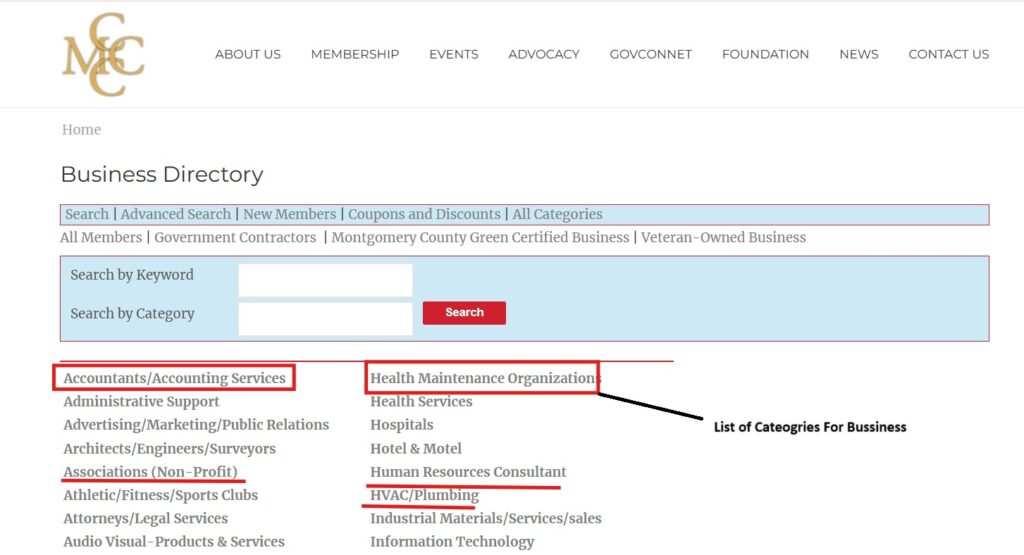
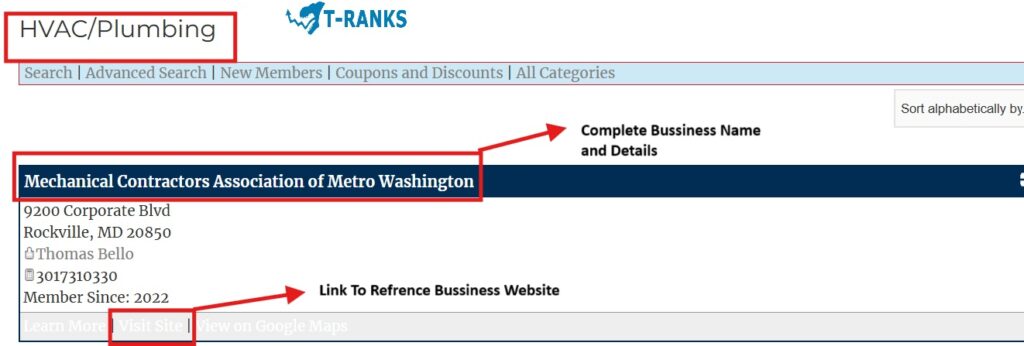
How to Get Included:
- Visit your city or county’s official website
- Navigate to sections like “Business Directory,” “Community Resources,” or “Approved Vendors”
- Look for submission forms or contact info — many allow self-submission
- Ensure your business info is complete, up-to-date, and professional
- If required, show your registration or license number for eligibility
Tip: Use Google to uncover opportunities:
site:.gov “submit your business” + city
site:.gov “community directory”
site:.gov “approved vendors”
Why This Strategy Works:
- Backlinks from .gov domains carry strong trust and geo-relevance
- These links are often placed contextually in official public service pages
- Listings are long-term and frequently used by citizens, news outlets, or other government pages
- You build both authority and visibility in your geographic target area
- It helps your business appear in local pack results by reinforcing trust signals
Caution:
Avoid scammy directories pretending to be “gov listings.” Always verify that the URL ends in .gov and that the site is part of a verified municipality or agency.
4. Replace Broken Links on Government Pages
Government websites often link to external tools, reports, or references. Over time, many of those links break—leaving users with dead ends and outdated resources. If you can offer a valuable, up-to-date alternative, you can earn a highly authoritative .gov backlink.
How to Find and Replace Broken .Gov Links
Start by identifying broken outbound links on .gov resource pages using tools like:
- Ahrefs (Broken Outbound Links report)
- Screaming Frog SEO Spider
- Check My Links (Chrome Extension)
Google search operators like:
site:.gov inurl:resources “404”
site:.gov “page not found”
Look for dead links in:
- Public resource hubs
- Old grant partner listings
- Downloadable PDF indexes
- Educational or small business sections
Once you find a dead link that aligns with your expertise, create (or link to) a page on your site that offers similar or improved value.
How to Pitch Your Replacement (and Why It Works)
Reach out to the webmaster or content editor with a respectful, helpful message. Example:
Hi, I noticed a broken link on your [Page Title]. I’ve created an updated version of that resource, which might help your users. Feel free to review it and include it if useful.
Make sure your page:
- Is non-promotional and genuinely helpful
- Aligns with the page’s civic or informational goal
- Loads fast and looks trustworthy
Why This Strategy Works:
- You’re solving a real issue for them—no spam, just value
- Most .gov pages don’t update often, so your link can stay live for years
- The backlink is contextual, editorial, and carries strong link equity
- It strengthens your authority, especially for educational, nonprofit, or public-interest content
5. Offer Expert Insights or Data to Support Government Content
Government agencies regularly cite external research, statistics, and expert contributions to support their reports, public-facing guides, and educational materials. If you publish original data, case studies, or whitepapers that align with public goals, you can earn .gov backlinks by contributing meaningful insights.
What Kind of Content Works?
Your contribution doesn’t need to be academic—but it must be non-promotional, factual, and publicly relevant. Ideal formats include:
- Original survey data (e.g., cybersecurity awareness, local health trends)
- Case studies on public innovation, education access, or civic engagement
- Policy-aligned reports that support government missions
- Visual summaries (charts, infographics) that explain complex topics clearly
For example, if your organization publishes a study on energy consumption in rural schools, that could be cited on energy.gov or a state Department of Education site.
How to Pitch It
- Find government agencies or departments working in your subject area.
- Search for pages like “Reports,” “Partners,” “Case Studies,” or “External Resources.”
- Reach out with a brief email highlighting your findings and why they’re relevant.
- Offer open access or limited-use permission (e.g., Creative Commons license).
Keep it short and focused on public value, not self-promotion.
Hi [Name], we recently published a data brief that may support your readers. It highlights [key topic] and includes updated figures on [statistic]. We’d be happy to offer it as a reference or summary—feel free to review and include it if useful.
Why This Strategy Works:
- Government agencies prefer credible, expert-based sources—not blog opinions.
- These backlinks are editorial, trusted, and semantically relevant.
- Once cited, they often stay live for years without needing updates.
- It reinforces E-E-A-T by associating your brand with public sector credibility—especially in fields like healthcare, education, and finance.
6. Collaborate on Government Awareness or Education Campaigns
Government departments often run seasonal campaigns to educate the public about health, safety, environment, or civic participation. These campaigns frequently include pages where they highlight supporting partners, tools, and helpful resources. This creates a strong opportunity to earn a high-authority .gov backlink—without resorting to spam or manipulation.
If your content directly supports the goals of the campaign, such as a free public tool, guide, or research-based infographic, you can offer it for inclusion. For example, during Mental Health Awareness Month, a state’s health department may welcome a link to a free self-assessment quiz or informational article—if it’s accurate, user-friendly, and not commercial in tone.
You don’t need a large team or budget to find these opportunities. Many agencies publish editorial calendars, newsletters, or partnership calls around specific initiatives (e.g., wildfire prevention, vaccination drives, digital literacy). Simply identify a matching campaign and reach out with a short, respectful pitch offering your resource as a helpful addition.
To succeed:
- Make sure your content aligns with their mission.
- Keep it non-promotional and focused on public value.
- Offer clear usage permissions (e.g., free to share or embed).
These types of .gov backlinks are editorial, contextually relevant, and tied to active social themes—making them excellent signals for SEO, E-E-A-T, and user trust.
7. Interview Government Experts or Feature Their Work
Interviewing a government expert—or featuring their public work—can earn you a powerful and natural .gov backlink.
When you publish thoughtful, non-promotional content that highlights the contributions of government professionals, agencies often take notice. In many cases, they’ll link to your post from:
- Department blogs
- Community newsrooms
- Outreach or partner resource pages
- Email newsletters or event recaps
Why this strategy works:
- You provide visibility to their work, which aligns with public education goals.
- The content builds real topical authority and supports E-E-A-T.
- It creates a relationship that may lead to future mentions or collaborations.
How to do it:
- Identify individuals working in departments relevant to your niche (e.g., local economic development, environmental programs).
- Reach out with a short, respectful request for a quote or interview.
Hi [Name], I’m writing a short feature on [topic]. Would you be open to sharing a quick insight or update from your work? - After publishing, email them the link—invite them to share or request feedback.
Example:
A business blog interviews a local SBA representative about new grant programs. That article is later included in the agency’s monthly newsletter and added to their “community updates” page—earning a contextual .gov backlink.
8. Monitor Government RFPs and Public Vendor Listings
Government agencies regularly publish Requests for Proposals (RFPs) and vendor application opportunities for services like web design, training, marketing, consulting, and software development. When your business applies and is selected (or even shortlisted), your name and website often get listed on a public .gov page—creating a legitimate, high-trust backlink.
These links may appear in:
- Award announcements or bid results
- Approved vendor directories
- Contract reports or archived RFP pages
Why this strategy stands out:
- It’s underused in most backlink strategies
- Helps service providers, consultants, or agencies get mentioned on .gov domains
- The backlinks are editorial, earned, and tied to real-world contributions
Example:
Let’s say your agency bids on a city’s digital marketing contract. If shortlisted or approved, you might appear on a vendor page like:
cityname.gov/purchasing/vendors-list.html
or
stateprocurement.gov/contracts/approved-providers
These pages often stay live for months or years and are indexed by Google—passing link equity back to your site.
How to find these opportunities:
Use simple search operators like:
site:.gov “request for proposal” + [your service]
site:.gov “approved vendor” + [industry]
site:.gov “supplier registration” OR “partner directory”
Check your local city, county, or state procurement portals regularly. Some even allow you to sign up for email alerts when new RFPs are posted.
Pro Tip: Even if you don’t win the contract, being listed as a verified applicant or resource can still earn you a .gov backlink—without any outreach.
What to Avoid When Getting .Gov Backlinks
Not all .gov backlink strategies are safe. Misusing this tactic can harm your SEO instead of helping it. Google considers any manipulative, irrelevant, or low-quality backlink a violation of its spam policies.
Here’s a breakdown of the most common mistakes—and what to do instead.
1. Buying or Renting .Gov Backlinks
Some services claim to sell hundreds of .edu and .gov backlinks for a few dollars.
At first glance, this might seem like an easy win. But these cheap backlinks typically come from:
- Spammy blog comments
- Irrelevant or scraped pages
- Hacked or expired subdomains
- Low-quality PBN-style networks pretending to be .edu or .gov sites
⚠️ Why to Avoid It:
Buying backlinks is a direct violation of Google’s Link Spam Policies. If detected, it can lead to:
- Manual penalties
- Algorithmic ranking drops
- Long-term trust loss in your backlink profile
💡 Bottom line: No legitimate .gov domain sells backlinks. If someone is offering hundreds of government links for cheap, it’s not only ineffective—it’s a serious SEO risk.
2. Using Automated Link-Building Tools
Tools that auto-submit your links to .gov forums or scrape comment sections don’t build authority—they create link spam.
⚠️ Why to avoid: These links are usually nofollow, irrelevant, and quickly deleted. Google’s SpamBrain system is designed to detect such patterns.
3. Over-Optimizing Anchor Text
Stuffing your anchor with exact-match keywords like “best SEO company” looks manipulative.
✅ Use natural anchor text:
- Brand names
- Generic phrases
- Descriptive but balanced terms
4. Targeting Irrelevant Government Sites
A link from a government agriculture page won’t help your software site rank. Relevance matters.
✅ Always check:
- Is the page topically related?
- Will their audience benefit from my content?
5. Chasing Low-Quality or Abandoned .Gov Domains
Not all .gov sites are equal. Some have:
- Low traffic
- Thin or outdated content
- No real authority despite the domain extension
✅ Use tools like Ahrefs or Semrush to check:
- Domain Rating (DR)
- Traffic trends
- Referring domains
6. Building Links Too Fast
If you suddenly earn 10–20 .gov backlinks, Google might view it as unnatural—especially if other link sources are missing.
✅ Best practice: Keep your link velocity steady and diverse.
7. Creating Content Solely to Get a Link
Thin content written only to place a backlink won’t be accepted—and won’t rank.
✅ Focus on value: publish research, guides, tools, or public-interest content worthy of a .gov citation.
8. Ignoring Link Profile Diversity
Even if you get .gov backlinks, relying on them alone is a mistake.
✅ Build a natural link profile:
- .edu, .org, and .com domains
- Topical guest posts
- Industry mentions
✅ Summary Table: What to Avoid
| Mistake | Why It’s Risky |
| Buying or renting .gov links | Violates Google’s guidelines, can cause penalties |
| Using spam tools or auto-posters | Creates low-quality, easily flagged backlinks |
| Exact-match anchor stuffing | Triggers over-optimization filters |
| Linking from irrelevant gov pages | Offers no SEO value, may look manipulative |
| Targeting low-trust .gov sites | Weak authority, possibly abandoned |
| Sudden backlink spikes | Signals unnatural link-building behavior |
| Pitching low-value content | Won’t earn links; harms reputation |
| Relying only on .gov backlinks | Lacks diversity; fails to look natural |
Final Tip:
The best .gov backlinks are earned, not forced. Prioritize topical relevance, editorial placement, and ethical outreach. That’s what Google rewards—and what builds long-term SEO authority.
Conclusion
In conclusion, .gov backlinks offer unmatched authority, trust, and SEO value when earned through ethical and relevant strategies. From understanding different types of government sites to building relationships, contributing valuable resources, and avoiding manipulative tactics—success depends on offering genuine value and maintaining long-term credibility.
These backlinks are rare for a reason: they require effort, alignment with public interest, and high-quality content. But when acquired correctly, even a few can significantly boost rankings, visibility, and digital reputation.
Ready to build high-authority backlinks without shortcuts?
T-RANKS helps you earn safe, editorial links—including .gov opportunities—through proven white-hat strategies.
Contact us now to grow your domain authority the right way.
FAQs About .Gov Backlinks
What is a .gov backlink?
A .gov backlink is a hyperlink from a government website that uses the .gov domain extension. These sites are operated by official public institutions, making their links highly authoritative and trusted by search engines.
Are .gov backlinks good for SEO?
Yes. .Gov backlinks pass strong authority, improve credibility, and support better rankings—especially in competitive niches.
Are free .gov backlinks safe for SEO?
Yes, as long as they are earned ethically through content value, outreach, or partnerships. Avoid spammy or automated tactics.
How do I get .gov backlinks?
You can get .gov backlinks by offering expert insights, fixing broken links, creating civic resources, or collaborating on awareness campaigns.
Can I buy .gov backlinks?
No. Buying .gov backlinks is against Google’s guidelines and can result in penalties. Most legitimate .gov sites will only link to credible, non-commercial, public-interest content.
How can I earn high-quality .gov backlinks?
Focus on strategies like content contributions, public directories, or expert collaborations. These white-hat methods work best for sustainable SEO results.
✅ Need help building .gov backlinks the ethical way?
T-Ranks specializes in earning high-trust .gov links through outreach, content, and partnerships. We follow 100% white-hat practices to grow your domain authority naturally.
How can I find .gov backlink opportunities?
Use Google search operators like site:.gov “resources” or analyze your competitors’ backlink profiles with SEO tools.
Do .gov backlinks help with local SEO?
Yes. City or state government links are great for boosting geographic relevance and building trust in local markets.
What’s the best way to get a .gov link in 2025?
Offer real value—like public tools, civic education content, or research. Editorial, context-based links work best.
